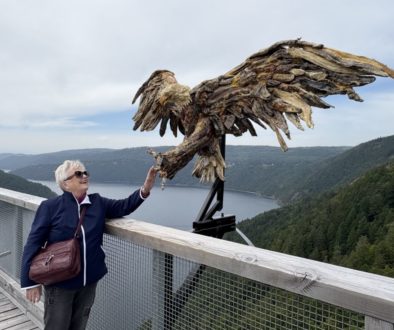Step Back into History at Old Fort Henry
May 21, 2022 was opening day for one of the most interesting forts in our Canadian history, Fort Henry, often referred to as Old Fort Henry. My constant travelling companion and I had been there before but were excited to have another look.

The Fort sits beside the Cataraqui River which flows into the mighty St. Lawrence River beside the since-built city of Kingston, Ontario. Here one of the Fort towers (with the red roof) keeps watch opposite the modern city on its perimeters.

The whole area was redolent with purple, white and mauve lilacs. I so wanted to pick a bouquet! Here the Cataraqui flows into the St. Lawrence. (And there’s another Fort tower!)

The garrison stores housed the Fort’s gift shop and I was anxious to see what historical books they might have. Unfortunately, most of the books were yellowed with age and hard to peruse on the very bottom shelf. I had to bend over and try to pull them from the shelves. I soon found my effort was not worth it. That was a disappointment partly because these shops often want to offer my four Loyalist books for sale but also because I saw nothing that would help me with my research for a new Loyalist book (series?) I’m working on.

The Fort itself was manned by acting soldiers in period dress, clicking their heels as they marched and firing off the cannons every so often. Here are two photos of those cannons and battlements.


We had a knowledgeable and pleasant tour guide who clicked his heels and marched us from one spot to the next with obvious pleasure. He told us that the lowest ranks wore red uniforms so that they would be easily spotted in the woods if they decided to run off from their soldierly duties. He was dressed in officers’ clothing which was much less obtrusive but still featured red on his hat.

Obviously this soldier on guard duty was of a lower rank!

The Fort does not have great towers or lookouts because it is built on such high ground along the edge of the St. Lawrence itself. Apparently when the Americans came across the St. Lawrence to have a look they decided that it was virtually impregnable and they would forgo trying to attack Fort Henry.

I was impressed by the clever things the British had built into the Fort as protection. The drawbridge had to be destroyed by going underneath it and loosening the whole thing, a tricky and time-consuming process. To keep the aggressors out, a special kind of ammunition could be fired around the corners and off the curved walls while an enemy might be trying to get across the drawbridge. The band played for us here.

This image shows the sheer size of the enclosed area and, of course, we watched the cannon firing. Not many people there on this first day of the season.
So why did we tour Fort Henry again? I wanted to refresh my memory for my new historical novel I am researching. It will feature United Empire Loyalists further east in Canada than my Loyalist trilogy did. Those three books centre on the Niagara area over into central Ontario, and the prequel goes back to prerevolutionary Boston. There is a wealth of material about those Loyalists who fled Boston during and just after the end of the American Revolutionary War.
While Fort Henry never saw battle it did house a number of political prisoners during World War I. Our guide told us that many of those were Ukrainians, “targeted because Ukraine was then split between Russia (an ally) and the Austro-Hungarian Empire, an enemy of the British Empire.” [From an article written for the Kingston Whig-Standard by Lubomyr Luciuk, professor of political geography at the Royal Military College of Canada, now near Fort Henry. Click to read the entire article.] Interesting how politics and world opinion change!

We came away from Fort Henry duly impressed by the fortification itself and by the knowledge and efficiency of the summer workers acting as tour guides. Here is the map from the Fort Henry National Historic Site situated on the St. Lawrence River at present-day Kingston. In 1812, it would have been much different but never forget that just across the river were those Americans, hungry for land and full of the pride in their new United States of America which they had wrested from England a little over thirty years earlier.
I can hardly wait to broaden my research further east, especially to New Brunswick and Nova Scotia. Keeping Canadian history alive and telling great historical fiction stories are so important and so interesting!
For more information on Fort Henry itself, click here.
Call for Submissions to an Anthology. Entries due by November 1, 2022: Click for Information.
For links to buy Elaine’s books, click the image below.





![Kathy riding Lexie (2[8] copy Kathy riding Lexie (2[8] copy](https://elainecougler.com/wp-content/uploads/2025/02/Kathy-riding-Lexie-28-copy-394x330.jpg)